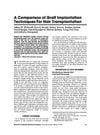 October 2021 in “Aesthetic Plastic Surgery”
October 2021 in “Aesthetic Plastic Surgery” New techniques in hair restoration surgery can lead to better hair alignment.
 3 citations
,
April 2020 in “Facial Plastic Surgery Clinics of North America”
3 citations
,
April 2020 in “Facial Plastic Surgery Clinics of North America” Beard hair transplantation is generally satisfying, requires 250-800 grafts, uses FUE to avoid scars, needs careful planning, has some risks, and hair regrowth starts after 4-6 months.
 2 citations
,
July 2018 in “Facial Plastic Surgery”
2 citations
,
July 2018 in “Facial Plastic Surgery” Hair restoration can enhance a facial plastic surgery practice with careful patient selection and detailed follow-up.

Surgical hair restoration can be done without hair transplantation.
 3 citations
,
November 2017 in “The American Journal of Cosmetic Surgery”
3 citations
,
November 2017 in “The American Journal of Cosmetic Surgery” The new Cosmetic Surgery Scar Assessment Scale (CSSAS) was found to be simple and effective in evaluating scars from hair restoration surgeries.
Methods to restore hair medically and surgically exist.

Non-transplantation methods can effectively restore hair.
Hair restoration and scalp surgery can effectively treat hair loss.
 July 2014 in “Plastic and Reconstructive Surgery”
July 2014 in “Plastic and Reconstructive Surgery” Hair follicles stored in a special medium and certain types of grafts have higher survival and growth rates after transplantation.
 14 citations
,
November 2013 in “Facial Plastic Surgery Clinics of North America”
14 citations
,
November 2013 in “Facial Plastic Surgery Clinics of North America” Hair transplant complications can be avoided with proper training and understanding.
 32 citations
,
November 2012 in “Aesthetic Surgery Journal”
32 citations
,
November 2012 in “Aesthetic Surgery Journal” Hair restoration surgery has advanced, focusing on natural results and may improve further with new techniques and therapies.
 5 citations
,
September 2003 in “Archives of Facial Plastic Surgery”
5 citations
,
September 2003 in “Archives of Facial Plastic Surgery” Follicular-unit grafting is an effective hair transplant method that looks natural and has a high success rate.
 November 2002 in “Hair transplant forum international”
November 2002 in “Hair transplant forum international” Hair restoration surgery is becoming less specialized.
 February 2000 in “Plastic and Reconstructive Surgery”
February 2000 in “Plastic and Reconstructive Surgery” The "Color Atlas of Hair Restoration Surgery" is a clear, practical guide for hair restoration procedures, covering topics like flaps, grafts, and planning, and is known for its helpful photos.
 August 1999 in “Current Opinion in Otolaryngology & Head and Neck Surgery”
August 1999 in “Current Opinion in Otolaryngology & Head and Neck Surgery” In 1999, surgical hair restoration improved a lot, making hair look more natural with fewer procedures, thanks to better scalp treatments and a new method called follicular-unit hair grafting.
 11 citations
,
June 1999 in “Seminars in Cutaneous Medicine and Surgery”
11 citations
,
June 1999 in “Seminars in Cutaneous Medicine and Surgery” The best hair transplant method depends on the desired look; faster techniques may not give better results or save money.
3 citations
,
January 1999 in “Hair transplant forum international” Hair transplant surgery can effectively treat hair loss in women.
 December 1998 in “The American Journal of Cosmetic Surgery”
December 1998 in “The American Journal of Cosmetic Surgery” Hair restoration should focus on quality and value, not cost, to maintain the field's reputation and ensure patient satisfaction.
 June 1998 in “Plastic and Reconstructive Surgery”
June 1998 in “Plastic and Reconstructive Surgery” Facial proportion is important in hair restoration surgery.

















